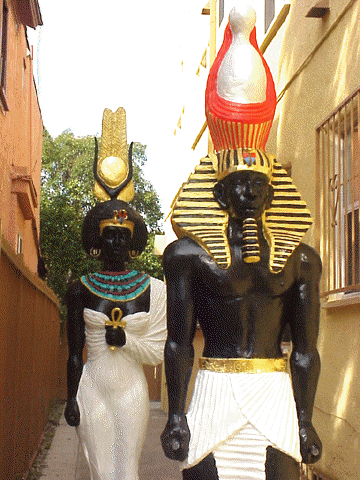Amber Larson, Seth Auberon, Ashley Wells, CC Liu, Dhr. Seven, Pat Macpherson, Crystal Quintero, Kelly Ani, Maya, Bhante (eds.), Wisdom Quarterly; Ven. Nyanatiloka WHY BUDDHISM?
 |
| The "flood" (ogha) of ignorance, sensual desire, craving for eternal existence, fear/anger comes over us like a tsunami sweeping us again and again out to sea to death and rebirth. |
 |
| Three colossal Buddhas in Burma, a tower, reclining, sitting (Mucki Nowak/flickr.com) |
Why does the idea of samsāra matter? In Eastern Philosophy or the tradition of the Dharmic religions, the problem is rebirth. Rooted in ignorance -- because, after all, it is illusory (maya) -- it leads to suffering, to wandering, to chasing fulfillment life after life. Each of the Dharmic religions offers a solution, but only Buddhism offers an ultimate solution.
 |
| Mara (Death) rules samsara (the wheel) |
It is beautiful, only it's not true. The heavens all come crumbling to an end, and one need not wait aeons to see this happening, for it happens from moment to moment. They are conditioned (composite things) nourished by karma that eventually becomes exhausted. Even the hells are this way.
Jainism had a view that rebirth into a higher plane beyond Brahma's retinue and even beyond Brahma was the solution. But that, too, only led to a very long lifespan among unconscious/insentient beings. From there being eventually fall to fare along according to their karmic desserts.
Wiser Brahmins (who so profoundly influenced Mahayana Buddhism) hit upon the idea that it was not Brahma but Brahman (the ultimate, the reality behind maya, the illusion) one was trying to get to, there to merge and unite like a differentiated drop in a vast undifferentiated ocean, losing personal identity. (Some more sophisticated Christian thinking follows along these lines as well, as early Christianity and particularly its universalist form, Catholicism, borrow so much from Hinduism without realizing it). Again, a very beautiful idea, but one still tainted with ignorance and illusion.
Wiser Brahmins (who so profoundly influenced Mahayana Buddhism) hit upon the idea that it was not Brahma but Brahman (the ultimate, the reality behind maya, the illusion) one was trying to get to, there to merge and unite like a differentiated drop in a vast undifferentiated ocean, losing personal identity. (Some more sophisticated Christian thinking follows along these lines as well, as early Christianity and particularly its universalist form, Catholicism, borrow so much from Hinduism without realizing it). Again, a very beautiful idea, but one still tainted with ignorance and illusion.
 |
| We die here, but what is reborn, what continues? |
He pointed out the roads to all rebirth destinations, explaining how this led to that rebirth and that to the other. But the end of all formations, the nirodha, was this realization of nirvana, this awakening (bodhi), this end of all suffering and rebirth.
What did the Brahmins and Mahayanists do? They quickly equated samsara with nirvana, the ordinary and oppressive with the extraordinary and ineffable, encouraging everyone to believe that this is it. This, here, enjoy! There's nothing to strive for, no salvation/liberation beyond this. This is the beyond, the beyond-the-beyond. This is not. This is samsara.
What did the Brahmins and Mahayanists do? They quickly equated samsara with nirvana, the ordinary and oppressive with the extraordinary and ineffable, encouraging everyone to believe that this is it. This, here, enjoy! There's nothing to strive for, no salvation/liberation beyond this. This is the beyond, the beyond-the-beyond. This is not. This is samsara.
Of course, there are sophisticated ways of thinking -- sophistry is like that -- where in a sense this is meshed in the other, it can be looked at like that from a certain angle if one crooks the head and squints the eyes, but this is so far from nirvana that for many Buddhists, particularly those who meditate, it is an insult to say that this is no different from that. This is beset by illusion, nirvana is not. This is wracked with pain and stained by tears, nirvana is not. This is marred by endless craving, nirvana is not. So then comes the final insult of thinkers who will not strive to experience nirvana or even gain a glimpse of it, but are content to "think" about it, argue, rationalize, and ponder:
Nirvana is not. Not this, not that, not anything -- OH, it is exactly contrary to what the Buddha said it was, and what so many arhats and noble ones (aryas) have confirmed it to be; that is to say, it is complete "annihilation." It is not annihilation. In fact, the Buddha said there are two extremes to avoid, two extremes in views, that of Eternalism and Annihilationism. And so much writing has gone into this point by the commentators that it is no sense to repeat it here. One could argue a whole lifetime and yet never know-and-see that nirvana is really beyond the beyond.
Those are the famous words of Mahayana's most famous apocryphal "discourse," something attributed to the Buddha or an early disciple that is more instructive than authentic. And isn't it interesting that while Mahayana rarely talks about the central tenet of the Buddha's teaching, anatta (Sanskrit anatman), it goes on and on about emptiness (shunyata) without seeming to realize what the "emptiness" refers to: things, all things (particularly the Five Aggregates of Clinging), are devoid of a permanent "self" (atta or atman). What Hinduism and Christianity worry about so much, ultimately, is not real. But conventionally it is, and we must strive to realize in what way it is real and what way it is not. How it is real and in what sense, many of us can see that. But how it is unreal and illusory, very few can see that. Yet, it is important to see. It is the key to enlightenment (bodhi) and nirvana (liberation).
The Heart Sutra (in brief)
 |
| The Heart of Wisdom |
 |
| Samsara: 31 planes simplified to six general planes |
What is the solution? Finding out (panna, prajna, knowledge, "wisdom," bodhi, awakening, enlightenment).
What is the path to finding out? This Noble Eightfold Path, which in detail is described in Theravada texts as the 37 Requisites of Enlightenment (bodhipakkhiya-dhamma), beautifully explained in ancient times by Ven. Nagasena somewhere in Afghanistan/ancient Greece/Bactria.
The problem: cycling
 |
| Stop the merry go round so I can get off. |
Samsāra is a Sanskrit/Pali word that means "round of rebirth," literally the perpetual or "continued wandering on" through the cycle of rebirths within a near infinite number of worlds categorized into 31 Planes of Existence.
It is a name designating the sea or flood (ogha) of life ever restlessly heaving up and down, a symbol of this continuous process of ever again and again being born, suffering, growing old, and dying.
 |
| Samsaric wandering never ends. |
More precisely put, samsāra is the unbroken chain of combinations of the five-fold aggregates (khandha) -- form (body), feelings, perceptions, formations, consciousnesses -- which are constantly changing from moment to moment and following continuously one upon the other through inconceivable periods of time.
| Heavens above, woe below, and here we are. |
Of this samsāra, a single lifetime constitutes only a tiny fraction. Therefore, to be able to comprehend the first noble truth of universal suffering (unsatisfactoriness, disappointment, ill, lack of fulfillment, misery), one must let one's gaze rest upon the entire cycle not a tiny fraction of it. Indeed, one life may be very happy, full of pleasure, joy, beauty, influence, and yet even then it is beset by the defilements and disappointment, dissatisfaction, a sense of emptiness with no way of finding fulfillment or satisfaction of craving and very little chance of ever finding an escape.
Samsāra, the frightful chain of rebirths, is not merely one single lifetime (even in a heavenly plane). It is the whole cycle, the whole impersonal process of karma and its results, of being sunk in ignorance, fettered by craving, inflamed by anger due to the frustration of our desires.
- Thee Marks of Existence (ti-lakkhana)
- It's all impersonal and not self (anattā)
- Ultimate truth (paramattha) differs from conventional experience
- Rebirth, reunion, relinking (patisandhi)















%2B%26%2BSkyline%2B-%2BThe%2BPeak%2B-%2BHong%2BKong%2B-%2BChine%2B14250947097_1bcb26f4bd.jpg)























































































































































































































































